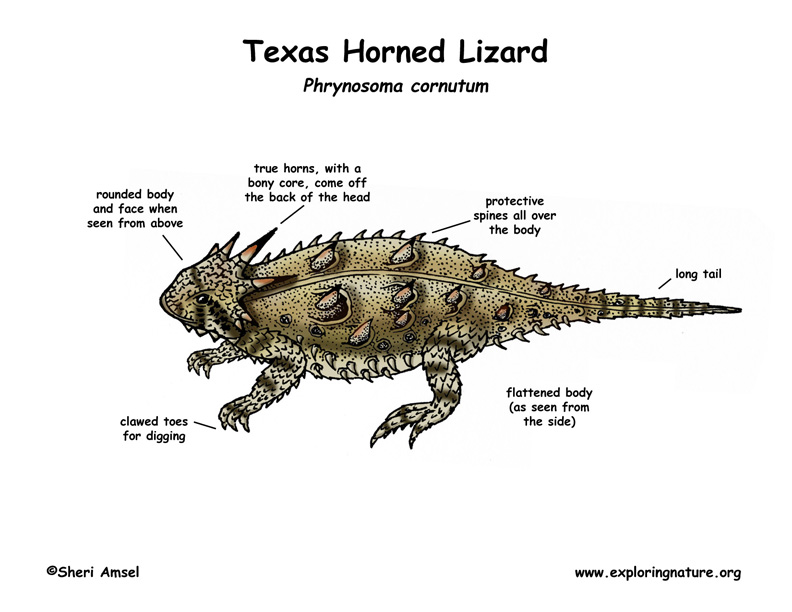

They are native to the southwestern U.S. in Colorado, Kansas, Arizona, New Mexico and Texas and down into northern Mexico.
They live near ant nests in scrubby grasslands, deserts and sandy areas.
They have a rounded body and face when seen from above, which has earned this lizard the nickname "horny toad." They are, however, lizards and reptiles and have a flattened body (as seen from the side) and short legs. They are covered with scales, some of which point outward forming protective spines all over the body. The spines are darker in color giving the lizard a spotted coloration on a tan or gray background. This acts as protective camouflage coloration. True horns (with a bony core) come off the back of their head. Females can reach 4.5 inches (11.5 cm) and males are smaller. The Texas horned lizard is the most common and largest of the many species found in the U.S.
They are active during the day (diurnal). To escape predation, they stay perfectly still to blend in. If they do try to escape, they run in short bursts, stopping suddenly to confuse predators. They will also puff up to a larger size, which pushes their spiny scales outward making them look more threatening. When threatened they can squirt blood out of a tiny opening around the eye. They are cold blooded and hibernate through much of the year - from late summer until early spring – by burrowing into the sand.
They eat mainly harvester ants, sitting quietly in the sand until one walks by, then snapping them up. They will also eat grasshoppers, beetles and other termites.
Females lay small, white, marble-sized eggs in the sand in mid spring to early summer. They take up to 55 days to hatch and hatchling start to eat ants on their own. They are born with spines and have no protection from their parents.
They can live for 5 years in captivity - less in the wild. They are threatened in parts of their range from over-collection. Their range is also shrinking from habitat loss due to human development and from harvester ants being displaced by the spread of fire ants and human use of pesticides.
Kingdom: Animalia
Phylum: Chordata
Subphylum: Vertebrata
Class: Reptilia
Order: Squamata
Suborder: Iguania
Family: Phrynosomatidae
Genus: Phrynosoma
Species: Phrynosoma cornutum
When you research information you must cite the reference. Citing for websites is different from citing from books, magazines and periodicals. The style of citing shown here is from the MLA Style Citations (Modern Language Association).
When citing a WEBSITE the general format is as follows.
Author Last Name, First Name(s). "Title: Subtitle of Part of Web Page, if appropriate." Title: Subtitle: Section of Page if appropriate. Sponsoring/Publishing Agency, If Given. Additional significant descriptive information. Date of Electronic Publication or other Date, such as Last Updated. Day Month Year of access < URL >.
Amsel, Sheri. "Lizard (Texas Horned ) - Also called Horned Toad" Exploring Nature Educational Resource ©2005-2024. December 14, 2024
< http://www.exploringnature.org/db/view/536 >

